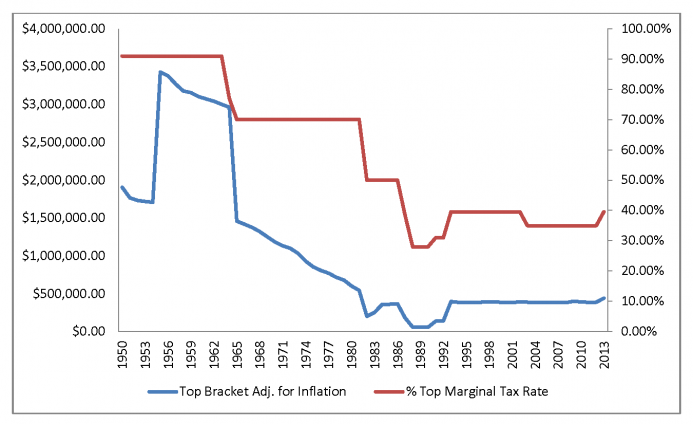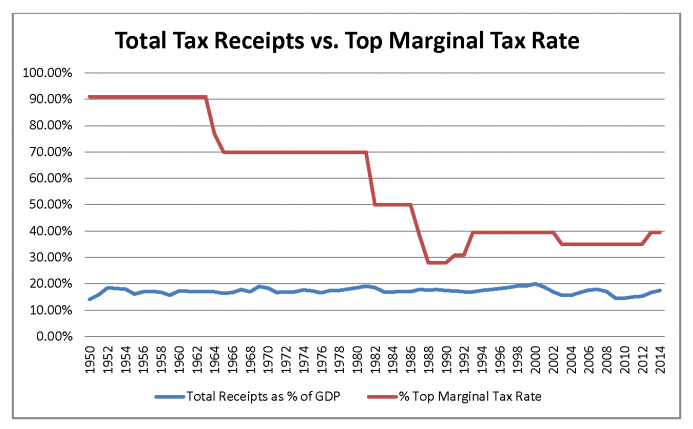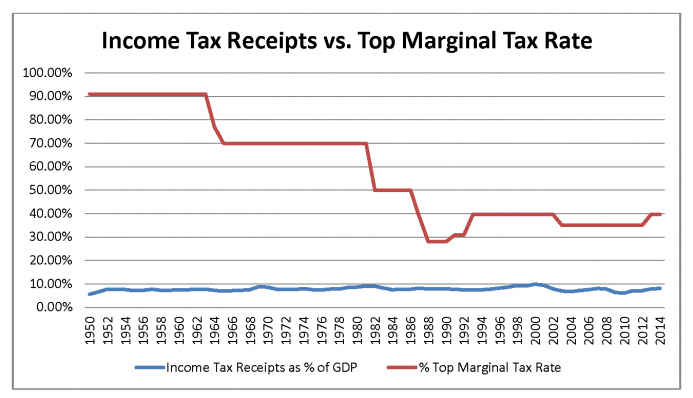Real Tax Rates In The 60s Were Much Lower Than Ocasio-Cortez Thinks – OpEd
By MISES
By Andrew Syrios*
Newly elected congresswoman Alexandria Ocasio-Cortez may not be the expert on the Israeli and Palestinian conflict or what the three branches of the American government are, but she certainly thinks herself an expert on tax and energy policy. Her energy policy involves reducing carbon emissions to zero within 12 years.
What will pay for the enormous amounts of subsidies necessary to make this happen? Well, it’s simple. As she says, “People are going to have to start paying their fair share in taxes.”
(FYI, here’s the liberal definition of fair share: Fair share (noun): “More… A lot more.”)
She continued, “If you look at our tax rates back in the 60’s … once you get to like the tippy tops, on like your ten millionth dollar. Sometimes you see tax rates as high as 60 or 70 percent.”
In other words, the United States, with a measly 37 percent as its highest tax bracket, should join the rest of the developed world with radically higher taxes. Just like, say, Finland (45 percent), the United Kingdom (45 percent), South Korea (40 percent), Norway (38.52 percent), New Zealand (33 percent) or Hong Kong (15 percent). (The highest income tax bracket in the world is Sweden at 61.85 percent, although the average for EU countries is 39 percent, only two points higher than the United States.)
This line of thinking is not new on the Left. In fact, Cortez got here numbers mixed up. She was supposed to say 90 percent. Back in 2016, Bernie Sanders noted that “When radical, socialist Dwight D. Eisenhower was president, I think the highest marginal tax rate was something like 90 percent.” Paul Krugman said the same thing as did Michael Moore in his film Capitalism: A Love Story and you’ll see this factoid repeated on countless memes floating around the Internet.
However, as Alexandria Ocasio-Cortez herself pointed out, what a tax rate is and what is actually paid are two very different things. Naturally, the average American would not be paying 70 percent of their income because these are marginal rates, so they would only pay on any earnings above the threshold. Indeed, in 1955, the only people paying 90 percent (actually 91 percent) were those making over $3,425,766 when adjusted for inflation in 2013 dollars. But while Cortez is right about marginal rates, what actually happened in the 1950’s and 1960’s completely undercuts her argument.
Tax Rates in the 1950s and 1960s
Tax law has changed a lot over the years. As you can see by looking at the top marginal rate versus the inflation-adjusted top income bracket for those filing jointly from 1950 until 2013:

Today, there are seven tax brackets. In 1989, there were only two. In 1955, there were an utterly ridiculous twenty-four different tax brackets.
Regardless, one should ask how much the rich were actually paying. It should be noteworthy that back in the 1950s, the government wasn’t actually collecting any more in tax revenue as a percentage of GDP. There’s something called Hauser’s Law, which basically states there is a maximum threshold on how much the government can tax out of its population. I believe this “law” is no such thing. If the government really wanted to expropriate more, it could do so. But Hauser’s Law is based on the fact that in pretty much every year since 1950, the government has collected between 16 and 20 percent of GDP in taxes. Here are the government tax receipts compared to the top marginal tax rate:

As you can see, no matter what the rate has been, the tax receipts have pretty much been the same. In 2017, it was 17.01 percent. Whether or not you can raise the amount collected is really immaterial here. The only thing that matters is what has happened (particularly when tax rates were over 90 percent) and it’s pretty much always been the same.
Of course, there are a lot of other taxes than personal income taxes. Still, tax receipts from personal income taxes have consistently been between 7 and 9 percent . In 2014, they were 8.1 percent. Furthermore, as you can see, the chart looks pretty much the same when looking at personal income tax receipts and the top marginal tax rate.

But Alexandria Ocasio-Cortez might retort by asking who is paying these taxes? Has the burden fallen more on the middle and lower classes? Well, no. In fact, the percentage of taxes paid by the highest quintile of income earners has steadily gone up since 1980. In 1980, the top 20 percent paid about 55 percent of all income taxes. Today, it’s just shy of 70 percent. The same goes for the top 1 percent, which went from about 15 percent in 1980 to just shy of 30 percent today.
The first of many reasons that this was the case is again what Cortez herself pointed out; that we need to look at the adjusted tax rate, not the top marginal tax rate. So for example, if I make $20,000, I owe 10 percent under today’s tax code, but only on any income over $18,450 (filing jointly). So I only owe 10 percent of $1550, or $155. Yes, my marginal tax rate may be 10 percent, but the real amount I pay is 0.78 percent.
A study from the Congressional Research Service concluded that the effective tax rate for the top 0.01 percent of income earners during the period of 91-percent income taxes was actually 45 percent. Given that the top bracket is so much lower today ($3,425,766 in 1955 vs. $500,001 in 2018), the 37 percent top marginal rate probably yields something pretty close.
This dynamic was also partly because corporate rates have always been lower than 50 percent. And as Alan Reynolds noted, when the personal income tax rates were reduced, it “… induced thousands of businesses to switch from filing under the corporate tax system to filing under the individual tax system.” In other words, many rich people kept their money in corporate entities when personal tax rates were higher.
Another major factor was the myriad of deductions and loopholes that used to be available. Many of these were eliminated by the Tax Reform Act of 1986 , which by no coincidence coincided with the biggest rate deductions. For one, interest had previously been deductible on all loans. After the act, it has only been deductible on home mortgages .
But what was probably the biggest lost deduction for wealthy individuals was the elimination of deductions on passive investment losses for real estate. Before 1986, wealthy individuals would often buy real estate with no hopes at all of their properties cash flowing. That wasn’t the point. The point was that real estate is depreciated every year in the eyes of the IRS. Even though in the long run, properties usually go up in value, the IRS assumes that every twenty-seven-and-a-half years (39 for commercial property) a property’s value will depreciate to zero. (Technically—this only counts for the building value, which is usually about 80 percent of the price, and not the land’s value—but we’ll ignore that for simplicity’s sake.)
This “loss” can be written off. So, for example, say someone earning $100,000 a year buys a property worth $275,000. He rents out the property and breaks even on it. The tax code allows this person to write off $10,000 as a loss which can be counted against his income for that year. So now he only has to pay taxes on $90,000. If he owned ten such properties, his income would be zero, at least according to the IRS.
That deduction is now gone for everyone but “active” real estate investors, or those who invest in real estate as a career.
Indeed, one former tax accountant even made the case that there were so many deductions, loop holes and the like in the pre-1986 tax code that “… there was a massive amount of tax fraud at all income levels under the old code. It was so bad and so common that most people took pride in telling others how they cheated on their taxes.”
I’ll leave how true that statement is to the reader, but from what I’ve heard, it sounds about right.
Regardless, the simple fact is that the rich never paid 70 percent or 90 percent of their income in taxes or anything even remotely close to that. Alexandria Ocasio-Cortez will have to look elsewhere for how to rid the world of fossil fuels by 2041.
*About the author: Andrew Syrios is a partner in the real estate investment firm Stewardship Properties. He graduated from the University of Oregon with a degree in Business Administration and a Minor in History.
Source: This article was published by the MISES Institute


She referred to the “illegal occupation of Palestine”.Sounds like she understands it pretty well.Don’t worry though.She’ll soon be owned by the Israel Lobby like the rest of congress.